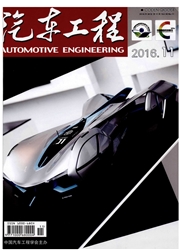

 中文摘要:
中文摘要:
针对纯电动汽车,提出了基于加速踏板行程的再生制动控制策略。当加速踏板行程超过一定门限值时,利用模糊控制算法计算出电机再生制动转矩,模拟发动机倒拖制动过程;建立电机和电池等模型,以加速踏板行程信号为输入条件,对上述控制策略和无发动机倒拖制动的控制策略进行dSPACE硬件在环对比仿真。结果显示,采用提出的控制策略后,电机转矩能较好地跟随驾驶员的操作需求,发动机倒拖制动能回收一定的能量。
 英文摘要:
英文摘要:
A regenerative braking control strategy based on accelerator pedal travel is proposed for electric vehicle. When the accelerator pedal travel exceeds a certain threshold value, the regenerative braking torque of mo- tor is calculated with fuzzy control algorithm and the process of engine drag braking is simulated. Then the models for motor and battery are created, a dSPACE hardware-in-the-loop comparative simulation is conducted on both the control strategy proposed and that without engine drag braking with the signal of acceleration pedal travel as input. The results show that with the control strategy proposed, the motor torque can well follow the driver's operation re- quests and the engine drag braking can recover a certain amount of energy.
 同期刊论文项目
同期刊论文项目
 同项目期刊论文
同项目期刊论文
 Coaxial-coupling traction control for a four-wheel-independent-drive electric vehicle on a complex r
Coaxial-coupling traction control for a four-wheel-independent-drive electric vehicle on a complex r Wheel torque distribution of four-wheel-drive electric vehicles based on multi-objective optimizatio
Wheel torque distribution of four-wheel-drive electric vehicles based on multi-objective optimizatio 期刊信息
期刊信息
